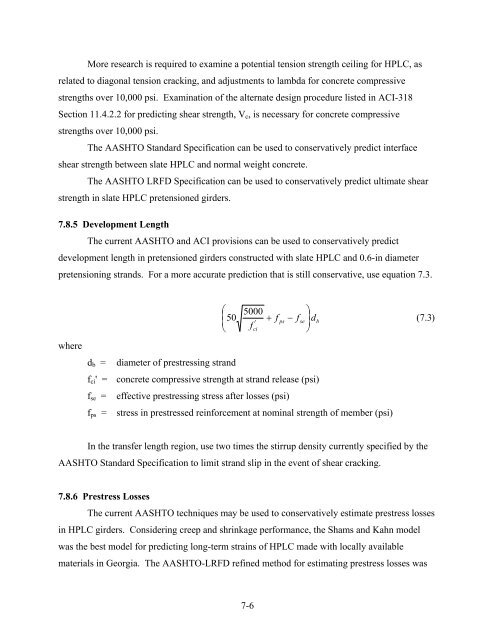Lightweight Concrete for High Strength - Expanded Shale & Clay
Lightweight Concrete for High Strength - Expanded Shale & Clay
Lightweight Concrete for High Strength - Expanded Shale & Clay
You also want an ePaper? Increase the reach of your titles
YUMPU automatically turns print PDFs into web optimized ePapers that Google loves.
More research is required to examine a potential tension strength ceiling <strong>for</strong> HPLC, as<br />
related to diagonal tension cracking, and adjustments to lambda <strong>for</strong> concrete compressive<br />
strengths over 10,000 psi. Examination of the alternate design procedure listed in ACI-318<br />
Section 11.4.2.2 <strong>for</strong> predicting shear strength, V c , is necessary <strong>for</strong> concrete compressive<br />
strengths over 10,000 psi.<br />
The AASHTO Standard Specification can be used to conservatively predict interface<br />
shear strength between slate HPLC and normal weight concrete.<br />
The AASHTO LRFD Specification can be used to conservatively predict ultimate shear<br />
strength in slate HPLC pretensioned girders.<br />
7.8.5 Development Length<br />
The current AASHTO and ACI provisions can be used to conservatively predict<br />
development length in pretensioned girders constructed with slate HPLC and 0.6-in diameter<br />
pretensioning strands. For a more accurate prediction that is still conservative, use equation 7.3.<br />
where<br />
⎛<br />
⎜<br />
⎝<br />
5000<br />
+<br />
f<br />
−<br />
⎟ ⎞<br />
⎠<br />
50 f<br />
' ps<br />
fse<br />
db<br />
ci<br />
d b = diameter of prestressing strand<br />
f ci ' = concrete compressive strength at strand release (psi)<br />
f se = effective prestressing stress after losses (psi)<br />
f ps = stress in prestressed rein<strong>for</strong>cement at nominal strength of member (psi)<br />
(7.3)<br />
In the transfer length region, use two times the stirrup density currently specified by the<br />
AASHTO Standard Specification to limit strand slip in the event of shear cracking.<br />
7.8.6 Prestress Losses<br />
The current AASHTO techniques may be used to conservatively estimate prestress losses<br />
in HPLC girders. Considering creep and shrinkage per<strong>for</strong>mance, the Shams and Kahn model<br />
was the best model <strong>for</strong> predicting long-term strains of HPLC made with locally available<br />
materials in Georgia. The AASHTO-LRFD refined method <strong>for</strong> estimating prestress losses was<br />
7-6















